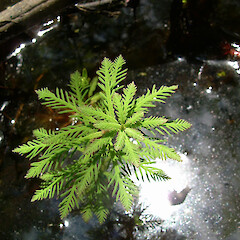Myriophyllum robustum
Common name
stout water milfoil
Synonyms
Myriophyllum variaefolium var. beta Hook.f.
Family
Haloragaceae
Flora category
Vascular – Native
Endemic taxon
Yes
Endemic genus
No
Endemic family
No
Structural class
Herbs - Dicotyledons other than Composites
NVS code
The National Vegetation Survey (NVS) Databank is a physical archive and electronic databank containing records of over 94,000 vegetation survey plots - including data from over 19,000 permanent plots. NVS maintains a standard set of species code abbreviations that correspond to standard scientific plant names from the Ngä Tipu o Aotearoa - New Zealand Plants database.
MYRROB
Chromosome number
2n = 28
Current conservation status
The conservation status of all known New Zealand vascular plant taxa at the rank of species and below were reassessed in 2017 using the New Zealand Threat Classification System (NZTCS) – more information about this can be found on the NZTCS website. This report includes a statistical summary and brief notes on changes since 2012 and replaces all previous NZTCS lists for vascular plants.
Please note, threat classifications are often suggested by authors when publications fall between NZTCS assessment periods – an interim threat classification status has not been assessed by the NZTCS panel.
- Conservation status of New Zealand indigenous vascular plants, 2017 . 2018. Peter J. de Lange, Jeremy R. Rolfe, John W. Barkla, Shannel P. Courtney, Paul D. Champion, Leon R. Perrie, Sarah M. Beadel, Kerry A. Ford, Ilse Breitwieser, Ines Schönberger, Rowan Hindmarsh-Walls, Peter B. Heenan and Kate Ladley. Department of Conservation. Source: NZTCS and licensed by DOC for reuse under the Creative Commons Attribution 4.0 International licence.
2017 | At Risk – Declining | Qualifiers: Sp
Previous conservation statuses
2012 | At Risk – Declining | Qualifiers: Sp
2009 | At Risk – Declining | Qualifiers: EF, Sp
2004 | Gradual Decline
Distribution
Endemic to the North and South Islands. In the North Island now known only from Northland to Taranaki and the northern Rangitikei. In the South Island known only from North West Nelson, the West Coast and Fiordland
Habitat
Shallow peaty lakes, slow flowing streams, dune ponds, and in muddy or seasonally flooded ground in alluvial forest.
Wetland plant indicator status rating
Information derived from the revised national wetland plant list prepared to assist councils in delineating and monitoring wetlands (Clarkson et al., 2021 Manaaki Whenua – Landcare Research Contract Report LC3975 for Hawke’s Bay Regional Council). The national plant list categorises plants by the extent to which they are found in wetlands and not ‘drylands’. The indicator status ratings are OBL (obligate wetland), FACW (facultative wetland), FAC (facultative), FACU (facultative upland), and UPL (obligate upland). If you have suggestions for the Wetland Indicator Status Rating, please contact: [Enable JavaScript to view protected content]
OBL: Obligate Wetland
Almost always is a hydrophyte, rarely in uplands (non-wetlands).
Detailed description
Perennial aquatic herb which if in pools of water is firmly rooted to the bottom. Stems spongy, inflated up to 1.5 m long, emergent portion 300 mm tall, erect to prostrate. Submerged leaves in whorls of (4–)5–7, (15–)20–35 x (4–)6–10 mm finely divided, pectinate with 26–32 pinnae, brown, these diminishing in size toward water surface. Emergent leaves glaucous, tinged red, narrowly ovate to oblong, apex acute, otherwise similar to submerged leaves. Flowers perfect. Sepals 4, ovate to deltoid 0.6–0.8 x 0.5–0.6 mm, petals 4, weakly hooded, 2.5–4 x 1–1.5 mm. Fruits globular to slightly turbinate, 1.5–2 x 2–2.5 mm.
Similar taxa
Similar to the naturalised M. aquaticum (Vell.) Verdc. from which it differs by being monoecious (males and females on the same plant), the exposed stems usually pink coloured and by the leaf tips, which are acute rather than blunted ended
Flowering
September – March
Fruiting
October – April
Propagation technique
Easy in a pond or in permanently damp soils. Can be grown from division of rooted pieces, by cuttings and seed. An attractive plant which should be more widely grown.
Threats
Threatened by wetland drainage, eutrophication, and the spread of naturalised wetland weeds.
Etymology
myriophyllum: Many leaves
robustum: Sturdy
Cultural Use/Importance
Myriophyllum robustum is proving popular as an aquarium and pond plant.
Attribution
Fact Sheet Prepared by P.J. de Lange (1 April 2007). Description based on fresh plants and herbarium material—see also Orchard (1979)
References and further reading
Orchard, A.E. 1979: Myriophyllum (Haloragaceae) in Australasia. 1. New Zealand: a revision of the genus and a synopsis of the family. Brunonia 2: 247-287.
NZPCN Fact Sheet citation
Please cite as: de Lange, P.J. (Year at time of access): Myriophyllum robustum Fact Sheet (content continuously updated). New Zealand Plant Conservation Network. https://www.nzpcn.org.nz/flora/species/myriophyllum-robustum/ (Date website was queried)














